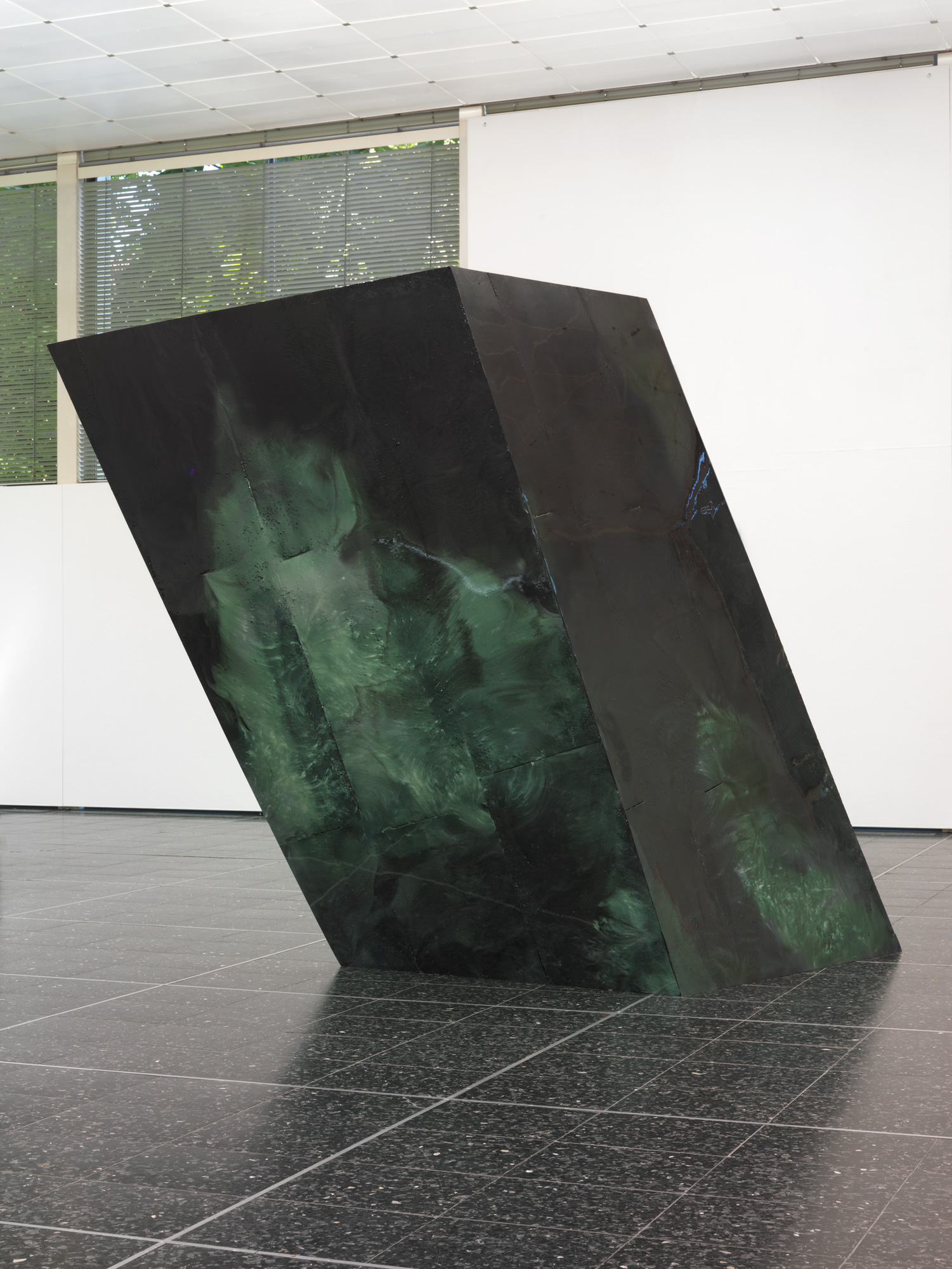
remedy II 2003
Jan Scharrelmann’s sculptures quite literally force the viewer “between the fronts”.
The viewer experiences a dichotomy of attraction and rejection, appeal and repulsion, widening and narrowing.
The artist also sees sculptural elements as conveyors of visual effects. He underpins their inherent structural tension by colouring the layers of epoxy resin in a process which completely alchemizes their appearance: iridescent aluminium, graphite or colour pigments trace the flow of the resin and lend the texture of the styrofoam a shimmering, three-dimensional, almost holographic quality.
We cannot help thinking of fantastic geological structures, of the surfaces of unexplored planets in distant galaxies, associations which run counter to the sheer force and mass of the sculptures that stand before us.
The reflecting skin of resin seems at once to serve as the transitional membrane between “inward depth” and “outward expanse” and as a means by which both the organic and spiritual energies of archaic, natural matter are captured and preserved.
As he contemplates this membrane and experiences all the associations of movement it awakens, the viewer becomes aware of his own reflected image and of the reflected happenings in the exhibition room around him. Mirrored thus, and for all its spatial dynamism, the room is more or less divorced from reality, transformed into a primarily visual phenomenon: the visibility and tangibility of things no longer coincide. The result is a sensation of placelessness and weightlessness, a feeling of uncertainty in respect of one’s own viewpoint and one’s own spatial experience.
Jan Scharrelmann’s works challenge not only the viewer’s spatiophysical sense of bearing but also his mental and spiritual state of being, not least through their wealth of associations, their many layers of contradictory sensory impressions and their seemingly implosive fields of energy. They take him beyond the sphere of the pragmatic and the rational.
Indeed, these “Remedies” may possibly exercise the healing powers promised by their title for anyone who is prepared to experience what they hold in store.
Jan Scharrelmann’s sculptures quite literally force the viewer “between the fronts”.
The viewer experiences a dichotomy of attraction and rejection, appeal and repulsion, widening and narrowing.
The artist also sees sculptural elements as conveyors of visual effects. He underpins their inherent structural tension by colouring the layers of epoxy resin in a process which completely alchemizes their appearance: iridescent aluminium, graphite or colour pigments trace the flow of the resin and lend the texture of the styrofoam a shimmering, three-dimensional, almost holographic quality.
We cannot help thinking of fantastic geological structures, of the surfaces of unexplored planets in distant galaxies, associations which run counter to the sheer force and mass of the sculptures that stand before us.
The reflecting skin of resin seems at once to serve as the transitional membrane between “inward depth” and “outward expanse” and as a means by which both the organic and spiritual energies of archaic, natural matter are captured and preserved.
As he contemplates this membrane and experiences all the associations of movement it awakens, the viewer becomes aware of his own reflected image and of the reflected happenings in the exhibition room around him. Mirrored thus, and for all its spatial dynamism, the room is more or less divorced from reality, transformed into a primarily visual phenomenon: the visibility and tangibility of things no longer coincide. The result is a sensation of placelessness and weightlessness, a feeling of uncertainty in respect of one’s own viewpoint and one’s own spatial experience.
Jan Scharrelmann’s works challenge not only the viewer’s spatiophysical sense of bearing but also his mental and spiritual state of being, not least through their wealth of associations, their many layers of contradictory sensory impressions and their seemingly implosive fields of energy. They take him beyond the sphere of the pragmatic and the rational.
Indeed, these “Remedies” may possibly exercise the healing powers promised by their title for anyone who is prepared to experience what they hold in store.
Kathrin Elvers-Svamberk, 2003